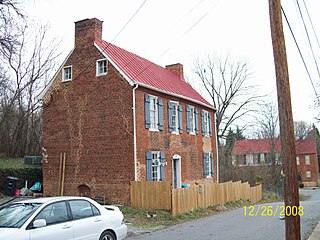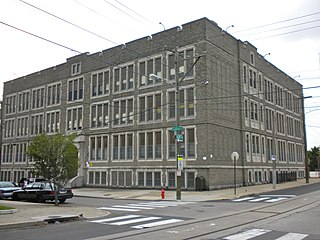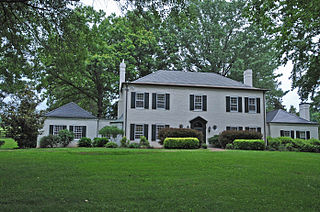
The Egyptian Building is a historic college building in Richmond, Virginia, completed in 1845. It was the first permanent home of the Medical Department of Hampden-Sydney College and now is a part of Virginia Commonwealth University. It is considered by architectural scholars to be one of the finest surviving Egyptian Revival-style buildings in the nation. The Egyptian Building was added to the Virginia Landmarks Register on November 5, 1968, the National Register of Historic Places on April 16, 1969, and finally designated as a National Historic Landmark on November 11, 1971.

The William Phaup House is a historic home located in Lynchburg, Virginia. It is a modest two story, four bay Federal style brick dwelling constructed about 1817. It is named after its architect and original occupant, William Phaup. Very few alterations have been made to the house since its construction.

Highland Park Public School is a historic school building located in Richmond, Virginia. The structure was built in 1909 based on a design by noted Virginia architect Charles M. Robinson. The Mediterranean Revival building is a two-story brick and stucco structure topped by hipped roofs clad with terra cotta tiles. In its use of the Mediterranean Revival style, the building was a departure from the Georgian and Gothic styles commonly used in Virginia school buildings of the time. The building used as the community school for Highland Park, Virginia, until the community was annexed by the City of Richmond in 1914. It served thereafter as a neighborhood school in the Richmond public school system until it closed in the 1970s. The building is considered to be important as an example of the work of Charles M. Robinson, who served as Richmond School Board architect from 1909 to 1930. The building was listed on the National Register of Historic Places in 1991. The building was converted from 1990 to 1991 into a residential apartment complex for senior citizens and re-opened under the name Brookland Park Plaza.

Nathaniel Bacon School is a historic school building located in Richmond, Virginia. The structure was built in 1914 based on a design by Charles M. Robinson, supervising architect, and William L. Carneal, architect. The Colonial Revival building is a 2+1⁄2-story brick structure located in Richmond's Oakwood/Chimborazo Historic District. The school was "a focal point of the Chimborazo neighborhood." The school was named for Nathaniel Bacon, the leader of Bacon's Rebellion. It served as an elementary school in the Richmond Public Schools from the time of its opening in 1915. In 1958, it was converted for use as a school for African-American students. In 1971, it was converted into a junior high school and renamed the East End Junior High School Annex. The building ceased operating as a school in the 1980s. It was listed on the National Register of Historic Places in 1992.

Roseville Plantation, also known as Floyd's, is a historic plantation home located near Aylett, King William County, Virginia. The main house was built in 1807, and is a 2 1/2-story, four bay, frame dwelling in the Federal style. It sits on a brick foundation and is clad in weatherboard. Also on the property are the contributing one-story, one-bay detached frame kitchen; a one-story, two-bay frame school; a large, one-story, single-bay frame granary; a privy, a 1930s era barn, and two chicken houses, of which one has been converted to an equipment shed. The property also includes a slave cemetery and Ryland family cemetery.

Windsor Shades is located on the Pamunkey River in Sweet Hall, Virginia, United States, that is listed on the National Register of Historic Places. Archeological native artifacts found on the property surrounding the house suggest it was the site of Kupkipcok, a Pamunkey village noted on John Smith's 1609 map.

The Matthew Fontaine Maury School, in Fredericksburg, Virginia, is an historic school building noted for its Colonial Revival architecture and design as well as its significance in the entertainment and cultural life of Fredericksburg. The architect of the building was Philip Stern. Built in 1919-1920, the school was used from then until 1952 for both elementary and high-school students. After the construction of James Monroe High School, the building was used as an elementary- and middle-school. The school was closed in 1980. Maury School was added to the National Register of Historic Places in March 2007.

William Henry Harrison School is a historic school building located in the Yorktown neighborhood of Philadelphia, Pennsylvania. It was designed by architect Irwin T. Catharine (1883–1944) and built in 1928–1929. It is a three-story brick building, nine bays wide on a raised basement in the Late Gothic Revival-style. It features a one-story, stone entrance pavilion with a Tudor-arched opening and a crenellated parapet. It is named for President William Henry Harrison.

The Church Hill North Historic District is a historic district in Richmond, Virginia, that was listed on the National Register of Historic Places in 1997. An expansion of the district was listed in 2000. This added 37 acres (15 ha) to the original 70 acres (28 ha)

US Post Office-Arlington is a historic post office building located in the Clarendon neighborhood of Arlington, Virginia. It was designed and built in 1937, and is one of a number of post offices designed by the Office of the Supervising Architect of the Treasury Department under Louis A. Simon. The building is a one-story, pentagonal shaped brick building in the Georgian Revival style. Atop the entrance portico is a dome that rises above the buildings flat roof and is supported by four fluted limestone piers. The interior features murals by Auriel Bessemer picturing Indians on Analostan Island, Captain John Smith and the Indians, tobacco picking by the Lee mansion, Robert E. Lee receiving his Confederate commission in Richmond, a picnic at Great Falls, polo players at Fort Myer, and a contemporary harvest at an apple orchard.

Dakota is a historic home located near Warrenton, Fauquier County, Virginia. The house was designed by architect William Lawrence Bottomley and built in 1928. It is a two-story, Colonial Revival style dwelling. It has brick facing over a masonry block core; a slate-shingled hipped roof; and a symmetrical five-bay facade with a centered entry with a classical surround. A one-story bedroom wing was added to the right of the house in 1948 and garage addition was added to the left of the house in 1948. Also on the property are the contributing original garage and a stable building. Dakota is located near the site of the former Horse Show Grounds outside of Warrenton.

Marriott School is a historic school building located near St. Stephens Church, King and Queen County, Virginia. The original section was built in 1938, and is a one-story, five bay, brick structure, flanked by a pair of four-bay wings in the Colonial Revival style. The front entrance is flanked by Doric order pilasters supporting a triangular entablature, the pediment of which is stuccoed. An addition was built in 1959. The school closed in 1992, and subsequently housed the King & Queen Branch of the Pamunkey Regional Library. The library moved to a new location in 2001.

Chase City High School, now known as Maple Manor Apartments, is a historic high school complex located at Chase City, Mecklenburg County, Virginia. The school building was built in 1908 and expanded in 1917. It consists of two two-story, brick Colonial Revival style buildings connected by a one-story connector building built in 1960. Also on the property is a contributing two-story, rectangular, brick building constructed in 1917 for vocational agriculture classes. A one-story, concrete block addition to the building was constructed about 1939. The school closed in 1980, and in 1991 the complex was sensitively rehabilitated for use as apartments for the elderly.

US Post Office-Christiansburg is a historic post office building located at Christiansburg, Montgomery County, Virginia. It was designed and built in 1936, and was designed by the Office of the Supervising Architect of the Treasury Department under Louis A. Simon. The one-story, five-bay, brick building is in the Colonial Revival style. It features a denticulated cornice and a standing-seam metal, gabled roof surmounted by a small, flat-roofed cupola. The interior features a Works Progress Administration sponsored mural by Paul DeTroot, depicting local events of the French and Indian and Revolutionary wars.

William H. McGuffey Primary School, also known as the McGuffy Art Center, is a historic elementary school located at Charlottesville, Virginia. It was built in 1915–1916, and is a two-story, rectangular, Colonial Revival style brick building. It features single-story Tuscan order porticos that project from each side elevation as well as from the front façade. It is topped by a slate covered, low pitched, hipped roof. It was named for William Holmes McGuffey (1800-1873) the author of the first standard U.S. reader series who was a staunch advocate of public education and a University of Virginia professor of moral philosophy. McGuffey School ceased to be a public school in 1973.

Randolph School is a historic school in Richmond, Virginia. The oldest part was constructed in 1896, with additions made in 1900, 1934, and 1952. It is a 2 1/2-story, brick school building in the Italianate style. It features a four-story entrance tower with a mansard roof, ornamental terra cotta string course, brick corbelling and window hoods. Some of the rooms retain their original tin ceilings.

St. Andrew's Church is an historic Episcopal church complex in Richmond, Virginia, United States. The complex consists of the church (1901), school (1901), parish hall (1904), Instructive Nurse Association Building (1904), and William Byrd Community House or Arents Free Library (1908). The church is a rough-faced Virginia granite, cruciform Gothic Revival style structure dominated by a 115-foot corner tower. The school and parish hall are three-story, brick buildings on a stone basements.

Belmont Methodist-Episcopal Church is a historic church building, located in the Belmont neighborhood of Roanoke, Virginia. The building currently (2019) belongs to the Metropolitan Community Church of the Blue Ridge, who acquired the building in 2003 and use it as their sanctuary.

C. W. Miller House, also known as the Mary Baldwin College Music Building, is a historic home located on the campus of Mary Baldwin University at Staunton, Virginia. It was built in 1899–1900, and is a 2 1/2-story, three bay, brick and stone building in a Châteauesque / Romanesque Revival style. It features four decorated brick chimneys with elaborately corbelled caps, a one-story wraparound porch, and a three-story round tower at the corner of the house. The house was sold to Mary Baldwin College in 1941 and houses the music school.

Williamsburg Inn is a historic large resort hotel located at Williamsburg, Virginia. It was built in three phases between 1937 and 1972. The original section was designed by Perry Dean Rogers Architects and is dominated by a two-story portico which stands atop a ground floor arcade. It is a three-story, seven-bay, Colonial Revival style brick structure. It has two-story flanking wings in an "H"-shape. The East Wing addition, also by Perry Dean Rogers Architects, consists of multiple wings of guest rooms set at right angles to one another. A third phase embracing the Regency Dining Room and its adjoining courtyard, was completed in 1972. The Williamsburg Inn is one of the nation's finest resort hotels, internationally acclaimed for its accommodations, service and cuisine. It represented John D. Rockefeller, Jr.'s commitment to bring the message of Williamsburg to a larger audience of influential Americans.
























